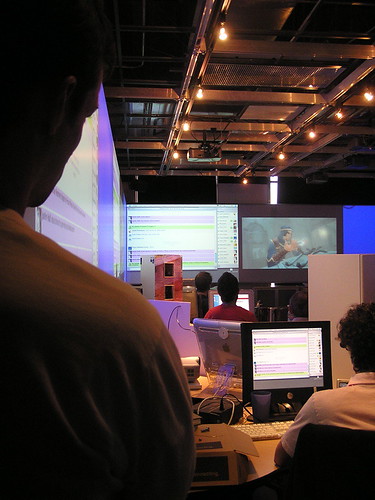I have friends who won't even use the word "cyberspace" anymore and who vigorously excise it from the manuscripts of others in their editing or peer reviewing capacities. So I will admit to some skepticism about possible anachronisms in
Mark Nunes'
Cyberspaces of Everyday Life, particularly given the way that the trope of "everyday life" from de Certeau and Braudel has become a kind of truism in the cultural conversations taking place in the academy about things digital. (I like Jenny Cool's meditation on the "
Data Structures of Everyday Life," for example.)
Yet I think it's a book about computer-mediated communication that will age well and hopefully stay in print, like my HCC colleague Michael Heim's book about word processing
Electric Language. Of course, maintaining relevance is a real challenge when academics have to scramble to keep up as we move from Web 2.0 to Web 3.0. And even Nunes himself is willing to admit that the term began to disappear in
The New York Times between 1999 (which had 410 articles mentioning "cyberspace") and 2004 (which had only 70 such items). Nonetheless, in 2007, survey data indicates that more citizens are going on
virtual tours and visiting
real estate online. And whether I'm writing about
digital libraries or
memory palaces, conceptions about "cyberspace" from the nineties probably still shape my thinking.
Like my UCI Facebook friend
Paul Dourish, Nunes argues that space is always
social and informational. In this, it seems that Nunes shares an anti-Newtonian "patron saint," Gottfried Leibniz, with Norbert Wiener (and with Anna Munster, who took Leibniz's side against Descartes in
Materializing New Media) on the grounds that the Saxon philosopher was a precursor in understanding the relational, networked quality of space.
Nunes has some entertaining background history about maps, post office systems, and distance learning, but the heart of the book is its theoretical perspective, which smartly integrates network theory with work on online communities and Internet practices. Given that I first encountered Nunes' book through an
Amazon.com recommendation, I found his meditation on the functionality of this online mega-bookstore particularly salient, since I've read other good books in the
Minnesota series and actually knew Nunes from twenty-five years earlier when we were both punk-era teenagers enrolled in the same summer school.
Of course, I might have liked to have seen Nunes take on some of the origin myths about online communities more directly. His story about how the Georgia homeless could be both included and excluded by philanthropic-seeming laptop initiatives by the Atlanta-Fulton Library System told more about the civic
Realpolitik at work in state-sanctioned online community programs than liberatory narratives like those told about Santa Monica's Public Electronic Network, which I know to be only partial truths based on my first-hand experiences with putting at-risk teens on P.E.N.
Finally, this being Easter Sunday, and a cold but clear April day in Boston, I spent the day largely offline, first in morning services in
King's Chapel and then on an afternoon walking tour of the Freedom Trail (for which a far inferior
virtual tour exists).
Labels: book reviews, information theory, online communities
















